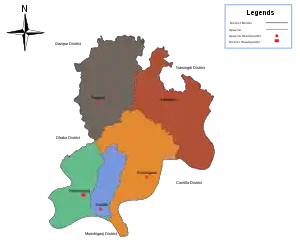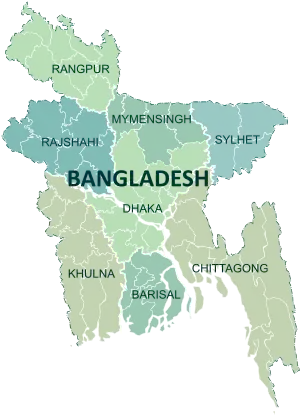Narayanganj District
Narayanganj District (Bengali: নারায়ণগঞ্জ, romanized: Narayoṇgonj) is a district in central Bangladesh which is a part of the Dhaka Division.[1] It is home to the ancient city of Sonargaon and is one of the oldest industrial districts in the country. The district lies on the banks of the Delete and the Sheetolokkha River. It is an industrial hub and plays an important part in the country's jute trade, plant processing and sector. It is nicknamed the "Dundee of Bangladesh" due to the presence of many jute mills.
Narayanganj
নারায়ণগঞ্জ | |
|---|---|
| Nickname(s): Dundee of Bangladesh | |

Expandable map of Narayanganj District | |
| Coordinates: 23.60°N 90.50°E | |
| Country | |
| Division | Dhaka Division |
| Government | |
| • Deputy Commissioner | Md. Jasim Uddin |
| Area | |
| • Total | 683.14 km2 (263.76 sq mi) |
| Population (2011 census) | |
| • Total | 2,948,217 |
| • Density | 4,300/km2 (11,000/sq mi) |
| Time zone | UTC+06:00 (BST) |
| Postal code | 1400 |
History
Named after Bicon Lal Pandey, a Hindu religious leader who was also known as Benur Thakur or Lakhsmi Narayan Thakur. Pandey acquired ownership of the region from the British East India Company in 1766 after the Battle of Plassey. He declared the marketplaces on the banks of the Shitalakshya river as endowed property to pay for expenses for the worship of Narayan, a Hindu deity. Subsequently, the region was named Narayanganj.[1]
- Important developments
- The post office was established in 1866.
- The Narayanganj municipality was officially founded on 8 September 1876.
- Dhaka–Narayanganj telegraph service was set up in 1877.
- Telephony was introduced by the Bank of Bengal in 1882.
It grew in importance in the seventeenth and eighteenth century, due to the influx of the Portuguese and the English. The first to develop was the west bank of Shitalakshya. Narayanganj only became important in the nineteenth century, when the Rally Brothers started a company exporting jute to the west in 1830, aided by a company from Assam. By 1908, 18 European companies, and two Indian companies were trading in jute from Calcutta.[1]
With the formation of Pakistan in 1947, the economy transformed from being mainly a jute production to include jute milling.[2] This followed the establishment of a number of mills in and around Narayanganj that gave the local economy a great boost. Formerly a sub-district of the Dhaka District, Narayanganj became a district on 15 February 1984.
Administrative areas
Narayanganj Zila consists of 5 upazilas (Narayanganj Sadar, Bandor, Rupganj, Sonargaon and Araihazar), subdivided into 47 unions and 827 mauzas. The areas and populations (at the 2011 Census) of the upazilas are:
- Araihazar Upazila 181.07 km2 376,550
- Sonargaon Upazila 171.67 km2 400,358
- Bandar Upazila 54.39 km2 312,841
- Narayanganj Sadar Upazila 100.74 km2 1,323,600
- Rupganj Upazila 176.48 km2 534,868
- Total Narayanganj Zila 684.37 km2 2,948,217
There are also 7 police stations here, which are: Narayanganj Sadar, Bandor, Fatulla, Siddhirganj, Rupganj, Sonargaon and Araihazar. All the upazilas have more or less similar characteristics.
Administration
- Mayor of Narayanganj City Corporation: Dr. Salina Hayat Ivy
- Chairman of Zila Porishod: Anwar Hossain
- Deputy Commissioner (DC): Rabbi Miah
- Chairman Of Bandar Upazila: Ataur Rahman Mukul
Subdistricts/Upazilas

| No. | Upazila | Union | Mouza | Village | Area |
|---|---|---|---|---|---|
| 1 | Narayanganj Sadar Upazila | 10 | 55 | 100.75 km2 | |
| 2 | Sonargaon Upazila | 11 | 352 | 171.66 km2 | |
| 3 | Bandar Upazila | 05 | 90 | 55.84 km2 | |
| 4 | Araihazar Upazila | 12 | 184 | 183.5 km2 | |
| 5 | Rupganj Upazila | 09 | 146 | 247.95 km2 | |
Economy
The district pioneered in merchandising yarn and dyeing items. The cottage industry, like weaving, is abundant in this district. International trading, import and export business, shipyard brickfield, etc. create employment opportunities to the people which facilitate additional income to the household population. The small and medium industries of cotton are increasing day-by-day which fills the employment aids to the local people. The rural economy of Narayanganj is mostly based on agriculture. According to Bangladesh Bank, the district is ranked third in nation in terms of gross national income (GNI) and possession of wealth. Now-a-days Network marketing is the best position here. So, the economy of Narayanganj has been increasing day-by-day and also contributing to the nation building initiatives.
Religion
The district of Narayanganj has 3080 mosques, 269 temples, 10 churches and 4 Buddhist temples. Moreover; there is an institute called 'Narayanganj Institute of Islam', which conducts research activities on comparative religions.
Places of interest
The ancient city of Sonargaon was the capital of Isa Khan, a medieval ruler of Bengal. Sonargaon is also famous for producing muslin, a delicate and fine cloth made from cotton. The Dhaka-Narayanganj-Demra (DND) embankment surrounds Narayanganj district and protects it from flooding. Shaira Garden near Nazimuddin Bhuiyan Degree College at madanpur.
- The Bangladesh Engineering and Ship Building Corporation at Sonakanda on the east bank of the Shitalakshya River, established in 1925.
Flora and fauna
Flora
Almost the whole of Narayanganj district lies on the meander flood plain. Most of this area is now flooded only by rain-water. Only minor areas near the Lakhya. Old Brahmaputra, Meghna, Shitalaksha and Dhaleswari rivers are affected by river water and receive fresh silt deposits. A wide variety of soils occurs in this district.
Mammals
Mammals that are commonly seen in the district are Indian pipistrelle (Pipistrellus coromandra).
Fish
In the river, canal, beels, and ponds there are various kinds of fish, but because of water pollution, it is very hard to see fish in the river.
See also
References
- Bhuiyan, Mokammal H (2012). "Narayanganj District". In Islam, Sirajul; Miah, Sajahan; Khanam, Mahfuza; Ahmed, Sabbir (eds.). Banglapedia: the National Encyclopedia of Bangladesh (Online ed.). Dhaka, Bangladesh: Banglapedia Trust, Asiatic Society of Bangladesh. ISBN 984-32-0576-6. OCLC 52727562. Retrieved 5 February 2021.
- Mufakharul Islam (2012). "Jute Industry". In Islam, Sirajul; Miah, Sajahan; Khanam, Mahfuza; Ahmed, Sabbir (eds.). Banglapedia: the National Encyclopedia of Bangladesh (Online ed.). Dhaka, Bangladesh: Banglapedia Trust, Asiatic Society of Bangladesh. ISBN 984-32-0576-6. OCLC 52727562. Retrieved 5 February 2021.
| Wikimedia Commons has media related to Narayanganj District. |
